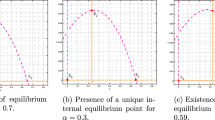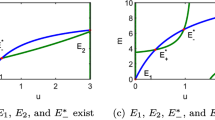Abstract
When searching for hosts, parasitoids are observed to aggregate in response to chemical signalling cues emitted by plants during host feeding. In this paper we model aggregative parasitoid behaviour in a multi-species host-parasitoid community using a system of reaction-diffusion-chemotaxis equations. The stability properties of the steady-states of the model system are studied using linear stability analysis which highlights the possibility of interesting dynamical behaviour when the chemotactic response is above a certain threshold. We observe quasi-chaotic dynamic heterogeneous spatio-temporal patterns, quasi-stationary heterogeneous patterns and a destabilisation of the steady-states of the system. The generation of heterogeneous spatio-temporal patterns and destabilisation of the steady state are due to parasitoid chemotactic response to hosts. The dynamical behaviour of our system has both mathematical and ecological implications and the concepts of chemotaxis-driven instability and coexistence and ecological change are discussed.
Similar content being viewed by others
References
Alt W., Lauffenburger D.A. (1985). Transient behaviour of a chemotaxis system modelling certain types of tissue inflammation. J. Math. Biol. 24: 691–722
Anderson A.R.A., Chaplain M.A.J. (1998). Continuous and discrete mathematical models of tumor-induced angiogenesis. Bull. Math. Biol. 60: 857–899
Barlow N.D., Beggs J.R., Moller H. (1998). Spread of the wasp parasitoid Sphecophaga vesparum vesparum following its release in New Zealand. N.Z. J. Ecol. 22(2): 205–208
Cameron P.J., Walker G.P. (2002). Field evaluation of Cotesia rubecula. an introduced parasitoid of Pieris rapae in New Zealand. Biol. Control 31(2): 367–374
Chaplain M.A.J., Stuart A.M. (1991). A mathematical model for the diffusion of tumor angiogenesis factor into the surrounding host tissue. IMA J. Math. Appl. Med. Biol. 8: 191–220
Chaplain M.A.J., Stuart A.M. (1993). A model mechanism for the chemotactic response of endothelial cells to tumor angiogenesis factor. IMA J. Math. Appl. Med. Biol. 10: 149–168
Chaplain M.A.J., Lolas G. (2005). Mathematical modelling of cancer cell invasion of tissue: the role of the urokinase plasminogen activation system. Math. Model. Methods. Appl. Sci., 15: 1685–1734
Geervliet J.B.F., Ariens S., Dicke M., Vet L.E.M. (1998). Long-distance assessment of patch profitability through volatile infochemicals by the parasitoids Cotesia glomerata and Cotesia rubecula. Biol. Control 11: 113–121
Geervliet J.B.F., Vreugdenhill A.I., Dicke M., Vet L.E.M. (1998). Learning to discriminate between infochemicals from different plant-host complexes by the parasitoids Cotesia glomerata and Cotesia rubecula. Entomol. Exp. Appl. 86: 241–252
Goldson S.L., Proffitt J.R., McNeill M.R., Baird D.B. (1999). Linear patterns of dispersal and build up of the introduced parasitoid Microctonus hyperode (Hymenoptera: Braconidae) in Canterbury, New Zealand. Bull. Entomol. Res. 89(4): 347–353
Hassell M.P., Wilson H.B. (1997). The dynamics of spatially distributed host-parasitoid systems. In: Tilman, D., Kareiva, P. (eds) Spatial Ecology. Princeton University Press, USA
Höfer T., Sherratt J.A., Maini P.K. (1995). Cellular pattern formation during Dictyostelium aggregation. Phys. D 85: 425–444
Holt R.D., Hassell M.P. (1993). Environmental heterogeneity and the stability of host-parasitoid interactions. J. Anim. Ecol. 62: 89–100
Keller E.F., Segel L.A. (1970). Initiation of slime mould aggregation viewed as an instability. J. Theor. Biol. 26: 399–415
Keller E.F., Segel L.A. (1971a). Model for Chemotaxis. J. Theor. Biol. 30: 225–234
Keller E.F., Segel L.A. (1971b). Travelling bands of chemotactic bacteria: a theoretical analysis. J. Theor. Biol. 30: 235–248
Lauffenburger D.A., Aris R., Kennedy C.R. (1984). Travelling bands of chemotactic bacteria in the context of population growth. Bull. Math. Biol. 46: 19–40
Maini P.K., Myerscough M.R., Winters K.H., Murray J.D. (1991). Bifurcating spatially heterogeneous solutions in a chemotaxis model for biological pattern generation. Bull. Math. Biol. 53(5): 701–719
McDougall S.R., Anderson A.R.A., Chaplain M.A.J., Sherratt J.A. (2002). Mathematical modelling of flow through vascular networks: implications for tumor-induced angiogenesis and chemotherapy strategies. Bull. Math. Biol. 64: 673–702
Murray J.D. (2002). Mathematical Biology. I: An Introduction. II: Spatial models and Biomedical Applications. Springer, New York
Pearce I.G., Chaplain M.A.J., Schofield P.G., Anderson A.R.A., Hubbard S.F. (2006). Modelling the spatio-temporal dynamics of multi-species host-parasitoid interactions: heterogeneous patterns and ecological implications. J. Theor. Biol. 241: 876–886
Petrovsikii S.V., Malchow H. (1999). A minimal model of pattern formation in a predator-prey system. Math. Comp. Model. 29(8): 49–63
Petrovsikii S.V., Malchow H. (2001). Wave of chaos: new mechanism of pattern formation in spatio-temporal population dynamics. Theor. Popul. Biol. 59: 157–174
Preedy, K., Schofield, P.G., Chaplain, M.A.J., Hubbard, S.F.: Disease induced dynamics in host-parasitoid systems: Chaos and coexistence. R. Soc. Interface, doi: 10.1098/rsif.2006.0184 (2006)
Rohani P., Miramontes O. (1996). Chaos or quasiperiodicity in laboratory insect populations? J. Anim. Ecol. 65(6): 847–849
Savill N.J., Rohani P., Hogeweg P. (1997). Self-reinforcing spatial patterns enslave evolution in a host-parasitoid system. J. Theor. Biol. 188: 11–20
Schofield P.G., Chaplain M.A.J., Hubbard S.F. (2002). Mathematical modelling of host-parasitoid systems: effects of chemically mediated parasitoid foraging strategies on within- and between-generation spatio-temporal dynamics. J. Theor. Biol. 214: 31–47
Schofield P.G., Chaplain M.A.J., Hubbard S.F. (2005). Dynamic heterogeneous spatio-temporal pattern formation in host-parasitoid systems with synchronised generations. J. Math. Biol. 50: 559–583
Schofield P.G., Chaplain M.A.J., Hubbard S.F. (2005). Evolution of searching and life history characteristics in individual-based models of hostf́bparasitoidf́bmicrobe associations. J. Theor. Biol. 237: 1–16
Sherratt J.A. (1994). Chemotaxis and chemokinesis in eukaryotic cells: the Keller–Segel equations as an approximation to a detailed model. Bull. Math. Biol. 56: 129–146
Sherratt J.A., Lewis M.A., Fowler A.C. (1995). Ecological chaos in the wake of invasion. Proc. Natl. Acad. Sci. USA 92: 2524–2528
Sherratt J.A., Eagan B.T., Lewis M.A. (1997). Oscillations and chaos behind predator-prey invasion: mathematical artifact or ecological reality? Phil. Trans. R. Soc. Lond. B 352: 21–38
Sherratt J.A. (2003). Periodic travelling wave selection by Dirichlet boundary conditions in oscillatory reaction-diffusion systems. SIAM. J. Appl. Math. 63(5): 1520–1538
Tyson R.C., Lubkin S.R., Murray J.D. (1999). Model and analysis of chemotactic patterns in a liquid medium. J. Math. Biol. 38: 359–375
Roosjen M., Pumarino L., Dicke M., Poecke R.M.P. (2003). Attraction of the specialist parasitoid Cotesia rubecula to Arabidopsis thaliana infested by host or non-host herbivore species. Entomol. Exp. Appl. 107: 229–236
Vos M., Berrocal S.M., Karamaouna F., Hemerik L., Vet L.E.M. (2001). Plant-mediated indirect effects and the persistence of parasitoid-herbivore communities. Ecol. Lett. 4: 38–45
Author information
Authors and Affiliations
Corresponding author
Additional information
I. G. Pearce gratefully acknowledges the financial support of the NERC.
Rights and permissions
About this article
Cite this article
Pearce, I.G., Chaplain, M.A.J., Schofield, P.G. et al. Chemotaxis-induced spatio-temporal heterogeneity in multi-species host-parasitoid systems. J. Math. Biol. 55, 365–388 (2007). https://doi.org/10.1007/s00285-007-0088-4
Received:
Revised:
Published:
Issue Date:
DOI: https://doi.org/10.1007/s00285-007-0088-4




